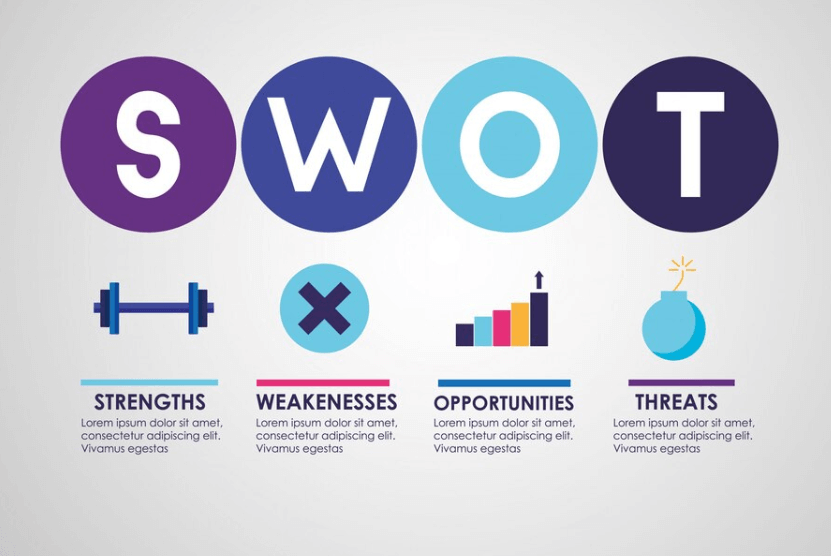A SWOT analysis is a strategic planning tool used to identify and understand the Strengths, Weaknesses, Opportunities, and Threats related to a business or project. This comprehensive approach helps organizations pinpoint internal strengths and weaknesses, as well as external opportunities and threats.
By evaluating these elements, businesses can formulate strategies that capitalize on their advantages, mitigate their weaknesses, optimize their potential, and defend against external challenges. The outcome of a SWOT analysis is invaluable in decision-making, setting objectives, and crafting strategies that lead to sustained growth and success.
Understanding SWOT Analysis in Detail
At its core, SWOT Analysis is a strategic framework utilized to evaluate a company or project’s competitive stance through identifying its Strengths, Weaknesses, Opportunities, and Threats. The technique employs a straightforward quadrant-based layout, breaking down these critical components into sections for a comprehensive overview.
While commonly associated with marketing, the versatility of SWOT Analysis extends far beyond, serving as a crucial tool in varied decision-making processes across both large and small-scale organizations.
Conducting a SWOT Analysis involves an in-depth review of both internal and external factors that influence an entity’s operational success. Internal factors encompass the strengths and weaknesses within the company’s control, whereas external factors highlight the opportunities and threats from external sources affecting the business landscape.
By simultaneously evaluating these internal and external dimensions, organizations gain a holistic understanding of their current state, potential future opportunities, and challenges, paving the way for strategic planning and action.
Employing SWOT Analysis in Marketing Strategies
Understanding the scope of SWOT analysis sets the stage for its application in a marketing context. The question then arises: why incorporate SWOT analysis into your marketing strategy? Utilizing SWOT analysis can significantly enhance your strategic planning by providing deeper insights into your marketing efforts.
This method is instrumental in addressing several pivotal questions that can refine your approach, such as identifying the strengths and weaknesses of your products or services, uncovering untapped market trends, recognizing new target demographics for longstanding offerings, and comparing your marketing tactics against those of your competitors.
Additionally, SWOT analysis can shed light on reasons behind customer attrition for specific products/services, the potential benefits of participating in trade shows, strategies for elevating brand awareness among specific demographics, and effective methods to increase subscription rates for free trials.
Initiating this analytical process is a decisive step toward understanding where your marketing strategy currently stands and what adjustments are necessary for amplified success. Whether pondering over the direction of your latest product campaign, encountering a project roadblock, or facing a specific challenge, convening with your team to conduct a SWOT analysis can illuminate a clear path forward, enabling more strategic, informed decision-making.
Simplified Guide to Conducting a SWOT Analysis
To effectively leverage a SWOT analysis for strategic planning, here’s a streamlined approach:
- Prepare Your SWOT Framework: Choose your format for the SWOT matrix. You could opt for a digital template or the classic whiteboard approach. Label each quadrant with Strengths, Weaknesses, Opportunities, and Threats to get your physical setup ready.
- Define Your Objective: Clearly specify your focus from the outset. What exactly do you aim to accomplish? Setting a specific goal with a measurable outcome and timeline is crucial for directing your SWOT analysis effectively.
- Collect Relevant Data: Research is vital. Gather all necessary data concerning internal and external factors pertinent to your objective. For teams new to SWOT, briefly explain the significance of each quadrant. Collect insights on your company’s strengths (like unique selling propositions and brand identity), pinpoint weaknesses (such as financial or technological limitations), explore potential opportunities (untried strategies or emerging markets), and identify threats (external risks or competitive challenges).
- Analyze and Apply Findings: After compiling your data, sift through to identify what’s most relevant to your goal. The subsequent step is applying this insight. Leverage your strengths to seize opportunities, transform weaknesses into strengths or mitigate their impact, and develop strategies to counter potential threats.
This condensed guide aims to streamline the SWOT analysis process, focusing on the essential steps to gather insights and formulate actionable marketing strategies efficiently.
Implementing SWOT Analysis: A Case Study from Minerva
Maria, Minerva’s marketing manager, conducted a SWOT analysis to understand customer dissatisfaction and identify new market opportunities for their women’s health wearable tech. The team, drawn from multiple departments, aimed to also boost morale by focusing on the company’s strengths amidst negative customer feedback. Their findings were as follows:
- Strengths: Exceptional engineering, robust sales network, high-quality products, and innovative R&D.
- Weaknesses: Delayed customer services, slow market adaptation, elevated production costs, and extended delivery periods.
- Opportunities: Easing regulations, demand for customized products, necessary R&D ventures, and a growing market.
- Threats: Foreign competition, technology rendering products old-fashioned, and the freshness of competitors’ ideas, along with heightened competition.
Outcomes: The analysis pinpointed that prolonged delivery and sluggish customer responses were harming the brand’s reputation and needed urgent attention. For the next marketing campaign, Maria identified deregulating countries with potential demand for customized products as prime targets.
Limitations of SWOT Analysis
While SWOT Analysis serves as an effective tool for gathering and organizing essential data, it’s crucial to recognize its limitations. SWOT brings together an entity’s strengths, weaknesses, opportunities, and threats, presenting a consolidated view that is directly aligned with the entity’s objectives. However, it’s imperative to understand that SWOT Analysis by itself does not provide:
- A list of action steps
- A strategy outline
- A hierarchy of prioritized solutions
- A definitive and focused conclusion
Therefore, while a SWOT Analysis offers a structured format for deliberation and discussion, it stops short of being a standalone solution. The real value of a SWOT Analysis emerges when its insights are integrated into the crafting of a comprehensive marketing strategy, utilizing the collected SWOT data to drive decision-making and strategic planning.

